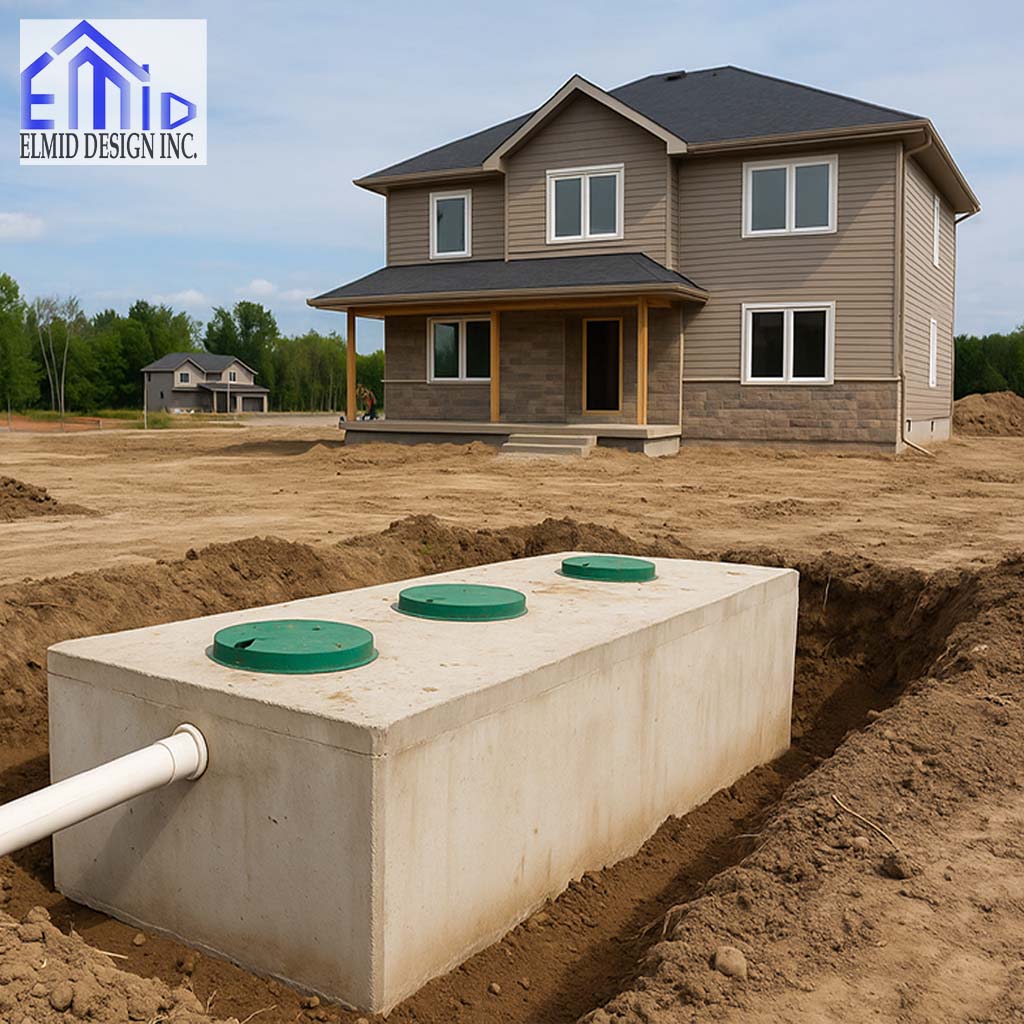Septic design Ontario is an essential process for any property not connected to a municipal sewer network. Across the province, thousands of homes, cottages, and rural properties rely on professionally designed septic systems to manage wastewater safely and efficiently. A properly engineered system not only protects the environment but also preserves property value and ensures compliance with the Ontario Building Code. Septic design in Ontario must consider multiple factors, including soil composition, groundwater levels, lot grading, and local health regulations. Because every site presents unique challenges, professional engineers play a vital role in developing systems that meet both functional and legal requirements. Firms such as Elmid Design Inc, authorized by Professional Engineers Ontario, deliver certified and precise septic designs that safeguard public health while meeting environmental sustainability goals. Understanding how septic systems are designed in Ontario helps property owners make informed decisions that lead to long-lasting, reliable wastewater management.
Importance of Septic Design in Ontario
A professional septic design Ontario ensures that wastewater is treated effectively before it returns to the environment. Ontario’s climate, soil types, and water table variations make designing septic systems a complex process that requires both engineering knowledge and local expertise. Without a proper design, systems can fail prematurely, leading to groundwater contamination, foul odors, and property damage. Engineers design systems that comply with Part 8 of the Ontario Building Code, which governs on-site sewage systems. Each design must meet strict standards for safety, capacity, and environmental protection. Proper septic design prevents contamination of drinking water sources and supports sustainable land use. The right design ensures long-term performance, protects natural resources, and reduces the risk of costly repairs.
Understanding How Septic Systems Work
A septic system functions as an on-site wastewater treatment unit designed to separate, treat, and filter household sewage. Septic design Ontario begins by analyzing how wastewater moves through a property’s soil and landscape. Wastewater from sinks, showers, and toilets flows into a septic tank where solids settle and bacteria break down organic matter. The partially treated liquid, called effluent, then flows to a leaching bed or filter bed for further purification through soil filtration. This natural process removes harmful pathogens and nutrients before the water seeps into the ground. Engineers design systems that maintain this natural balance, ensuring treatment efficiency and environmental safety. Understanding these principles allows designers to tailor each system to the property’s unique characteristics.
Key Components of Septic Design Ontario
Every septic design Ontario includes several core components that must be carefully planned to ensure long-term reliability. The primary element is the septic tank, which collects and pre-treats household wastewater. The second component is the distribution network that carries effluent from the tank to the leaching bed. The leaching bed, or drainage field, disperses the treated liquid into the soil for filtration. Engineers also include inspection ports, risers, and access points for maintenance and monitoring. Each component must be properly sized, placed, and constructed to meet hydraulic and environmental requirements. The design also considers property layout, landscaping, and future development potential. When each part is engineered correctly, the system operates efficiently with minimal maintenance.
Factors Affecting Septic Design in Ontario
Several environmental and technical factors influence septic design Ontario. Soil texture is one of the most important, as it determines how quickly wastewater is absorbed and filtered. Sandy soil allows rapid percolation, while clay-rich soil restricts drainage, requiring alternate solutions. Groundwater level, slope, and proximity to wells or surface water also affect design choices. Engineers must ensure adequate separation between the effluent discharge zone and the groundwater table to prevent contamination. The daily wastewater volume, based on the number of bedrooms and plumbing fixtures, determines tank size and bed area. Local climate also plays a role because freeze-thaw cycles can affect system performance. By evaluating these factors, engineers create designs tailored to each site’s specific needs.
Soil Testing and Site Evaluation
Soil testing forms the foundation of septic design Ontario. Engineers perform percolation tests to measure how quickly water infiltrates the soil. This data determines the type and size of the leaching bed. A detailed site evaluation follows, assessing topography, drainage patterns, and the presence of nearby wells or water bodies. The evaluation also identifies potential obstacles such as rocky ground or high groundwater. Engineers document these findings to develop an accurate and compliant design. Soil testing ensures the chosen system type will function effectively in local conditions. It also helps avoid costly design revisions and environmental risks. Without accurate site data, even the most advanced design cannot guarantee performance or compliance with Ontario’s environmental standards.
Regulatory Framework and Code Requirements
Septic design Ontario must comply with the Ontario Building Code, which sets minimum standards for design, installation, and operation. Part 8 of the code governs systems with a daily design flow of less than 10,000 liters. Larger systems fall under the Ministry of the Environment, Conservation and Parks regulations. Local health units, such as the Durham Region Health Department, review and approve permit applications based on engineered drawings and test results. Designs must demonstrate compliance with required setbacks, soil load capacity, and treatment efficiency. Engineers are responsible for preparing certified documentation and ensuring systems meet environmental and health protection standards. Compliance is not optional; it guarantees safety, legality, and environmental responsibility.
Common Septic System Types in Ontario
There are several types of systems used in septic design Ontario, each suited to specific conditions. The most common is the conventional gravity system, which relies on natural drainage to distribute effluent into the soil. In areas with poor drainage or high groundwater, mound systems are used to elevate the leaching bed. Aerobic treatment units provide enhanced treatment using oxygen, ideal for environmentally sensitive areas. Pressure distribution systems deliver effluent evenly across the bed for consistent absorption. Each system has distinct design and maintenance requirements. Engineers select the most suitable system based on soil, topography, and household usage. Choosing the right system type ensures both functionality and compliance with provincial standards.
Environmental Protection and Groundwater Safety
Environmental safety is central to septic design Ontario. Engineers focus on preventing contamination of groundwater and surface water sources. Proper design ensures that wastewater is treated through natural and mechanical processes before re-entering the environment. The soil acts as a biological filter, removing harmful pathogens and nutrients. Systems are designed with sufficient setbacks from wells, lakes, and rivers to prevent effluent migration. Engineers also account for seasonal water fluctuations and stormwater infiltration. In addition, environmentally sensitive areas may require advanced filtration or tertiary treatment systems. Protecting water quality is not only a regulatory requirement but a moral responsibility for engineers working in Ontario.
Engineering Expertise and Certification
Engineering expertise is essential in every septic design Ontario. Licensed engineers bring scientific knowledge and professional accountability to the design process. Firms such as Elmid Design Inc, certified under Professional Engineers Ontario, apply strict quality standards to every project. Their engineers assess soil characteristics, perform hydraulic calculations, and design systems that meet both technical and environmental criteria. Each design is sealed by a professional engineer, ensuring compliance and safety. Certification guarantees that systems are not only functional but also legally approved for construction. Engineering oversight transforms septic design from a routine process into a dependable, long-term infrastructure investment.
Choosing the Right Engineer for Septic Design Ontario
Selecting the right professional for septic design Ontario ensures that the system performs efficiently and remains compliant with regulations. Property owners should choose firms with proven experience, proper licensing, and familiarity with local soil conditions. A certified engineering firm handles all aspects of the design, including testing, documentation, and permit applications. Engineers maintain communication with health officials to streamline the approval process. Choosing a professional like Elmid Design Inc provides confidence that every aspect of the project meets safety, environmental, and technical standards. Reliable engineering support also simplifies future maintenance and upgrades, ensuring consistent performance over time.
Cost of Septic Design in Ontario
The cost of septic design Ontario varies depending on site conditions, system type, and property size. Basic designs for conventional systems are more affordable, while advanced treatment units or mound systems require additional engineering and materials. Soil testing, permits, and environmental assessments also influence total cost. Although professional design may appear costly upfront, it saves money in the long run by preventing premature system failure and environmental contamination. Proper design extends the system’s lifespan, reduces maintenance frequency, and ensures compliance with provincial standards. Investing in certified engineering design guarantees efficiency, reliability, and protection for both the property and the environment.
Role of Maintenance in Design Planning
Maintenance plays a significant role in septic design Ontario and must be considered during the planning phase. Engineers design systems that are easy to inspect, service, and pump. Access ports and risers are strategically positioned for future maintenance. Regular upkeep keeps the system performing efficiently and extends its lifespan. Engineers also provide maintenance schedules and operation manuals to guide homeowners. Designing with maintenance in mind reduces long-term costs and ensures consistent system performance. Proper planning at the design stage supports the long-term health of both the system and the surrounding environment.

Advanced Engineering Practices in Septic Design Ontario
Modern septic design Ontario applies advanced engineering techniques to create systems that combine efficiency, durability, and environmental protection. Engineers use computer-based modeling to simulate wastewater flow and soil absorption rates under various conditions. These models help identify the most effective configuration for tanks, leaching beds, and distribution lines. Hydraulic calculations ensure that effluent is evenly dispersed, preventing overloading in any section of the system. Engineers also evaluate how seasonal changes, such as freezing temperatures and heavy rainfall, affect system performance. This scientific approach allows for precise design adjustments that improve reliability and safety. Through continuous innovation, professional engineers transform traditional septic systems into sustainable, high-performance infrastructure tailored to Ontario’s unique climate and terrain.
Sustainable Solutions for Septic Systems in Ontario
Sustainability has become the foundation of septic design Ontario. Engineers focus on reducing environmental impact by integrating systems that use less energy and promote natural treatment processes. Environmentally conscious designs include energy-efficient pumps, advanced aeration units, and soil-based filtration methods that enhance purification. Engineers also select materials that resist corrosion and degradation, reducing waste and extending system lifespan. In rural and suburban areas, sustainability means designing systems that complement natural landscapes while minimizing excavation and disruption. Sustainable septic design reflects Ontario’s broader commitment to conservation, ensuring that wastewater management aligns with long-term ecological goals. These approaches protect both property and the environment while maintaining regulatory compliance.
Climate-Resilient Design Strategies
Climate change presents new challenges for septic design Ontario. Engineers now consider the effects of fluctuating weather patterns, increased rainfall, and freezing conditions when designing systems. Elevated mound systems and pressure distribution systems are often used to prevent flooding in areas with high groundwater. Insulation and proper burial depths help protect pipes and tanks from frost damage. Engineers also account for soil expansion and contraction caused by freeze-thaw cycles to maintain structural integrity. These strategies ensure that septic systems remain operational and efficient throughout the year. By integrating resilience into every design, engineers protect both the system’s longevity and the surrounding ecosystem from seasonal stress.
Smart Technology and Automation in Design
Technology is transforming septic design Ontario by enabling real-time monitoring and improved performance. Engineers now integrate smart sensors and control panels that track tank levels, flow rates, and pump operation. These automated systems send alerts when maintenance is required or when irregularities occur. Data collected from smart devices helps engineers refine future designs and optimize existing systems. This shift toward intelligent wastewater management reduces the likelihood of system failure and minimizes environmental risks. Automation also enhances convenience for property owners by simplifying maintenance and providing insight into system operation. The use of smart technology marks a significant evolution in Ontario’s approach to septic system design and management.
The Role of Licensed Engineers
Licensed engineers hold a critical role in septic design Ontario by ensuring every system meets both technical and environmental standards. Their professional credentials, governed by Professional Engineers Ontario, guarantee accountability and precision. Engineers oversee the entire process—from soil testing to final inspection—ensuring every step aligns with code requirements. Their expertise allows them to balance complex factors like hydraulic load, soil composition, and property layout. Engineers also provide sealed drawings required for permit approval, offering assurance to both homeowners and regulators. Professional oversight ensures reliability, safety, and environmental compliance, reinforcing public trust in Ontario’s wastewater infrastructure. The involvement of licensed engineers transforms a septic system from a simple installation into a scientifically engineered solution.
Inspection and Quality Assurance
Inspection and quality assurance form the backbone of septic design Ontario. Engineers conduct inspections at critical stages of design and construction to confirm that all specifications are met. During installation, they verify tank placement, pipe gradients, and soil compaction. These inspections prevent construction errors that could compromise the system’s efficiency. Engineers also review materials for compliance with approved standards, ensuring durability and performance. Quality assurance extends beyond installation, with follow-up evaluations to assess system operation and environmental impact. This rigorous process guarantees that every septic system built in Ontario performs safely, efficiently, and in accordance with provincial regulations.
Maintenance Planning During the Design Phase
Maintenance planning begins long before a septic system is installed. Engineers incorporate accessibility and serviceability into septic design Ontario to make upkeep straightforward. Components such as risers, inspection ports, and pump chambers are strategically located for easy maintenance. Engineers also plan for system expansion or modification should property needs change over time. Clear maintenance guidelines are included in design documentation to help homeowners manage their systems responsibly. This proactive approach reduces long-term costs and prevents system failures. By considering maintenance at the design stage, engineers ensure continued system efficiency, supporting both environmental sustainability and homeowner satisfaction.
Environmental Protection and Compliance
Environmental protection is central to septic design Ontario. Engineers design systems that minimize pollutant discharge and preserve groundwater quality. Proper separation distances between septic components and water sources prevent contamination. Soil layers act as natural filters that remove bacteria and nutrients from effluent before it enters groundwater. Engineers also integrate advanced treatment technologies that improve purification efficiency. These designs align with provincial initiatives for clean water and sustainable development. Compliance with environmental standards ensures that wastewater is treated safely without harming ecosystems. Each design not only meets technical requirements but also supports Ontario’s long-term environmental goals.
Collaboration Between Engineers and Municipal Authorities
Effective collaboration between engineers and municipal authorities ensures smooth project execution and regulatory compliance. In septic design Ontario, engineers work closely with local health units to submit documentation, testing results, and certified design drawings. Municipal authorities review and approve the design before construction begins. Regular communication between engineers and inspectors helps avoid delays and ensures transparency throughout the project. This partnership supports consistent enforcement of environmental and safety standards. Collaboration between professionals and regulators also builds community confidence in Ontario’s wastewater management system. Such coordination ensures that every system functions safely and contributes to a cleaner, healthier environment.
Cost and Value in Septic Design Ontario
The cost of septic design Ontario reflects the level of precision, testing, and compliance required by law. While professional design may involve upfront expenses, it delivers lasting value through efficiency and reliability. A properly engineered system reduces the risk of failure, contamination, and costly repairs. Engineers evaluate site-specific conditions to determine the most cost-effective solutions without compromising quality. Sustainable design practices further reduce long-term maintenance and energy costs. By investing in certified engineering services, property owners ensure compliance with regulations while protecting both their investment and the environment. Quality design provides financial stability and peace of mind for decades.
Adapting Septic Design for Urban and Rural Needs
Ontario’s diverse geography requires flexible engineering solutions for both urban and rural properties. In urban fringe areas, engineers design compact systems that maximize available space while maintaining high treatment efficiency. Rural properties often require larger systems capable of handling variable water usage and complex drainage patterns. Engineers adapt septic design Ontario to suit local soil types, topography, and infrastructure. Their goal is to create systems that meet specific property demands while aligning with environmental protection standards. This adaptability ensures that septic design serves every community, from rural farmlands to suburban developments.
Professional Leadership in Engineering
Elmid Design Inc exemplifies leadership in septic design Ontario through its commitment to innovation, sustainability, and professional excellence. The firm’s team of licensed engineers designs systems that meet Ontario Building Code requirements while prioritizing environmental protection. Each project undergoes rigorous analysis, ensuring accuracy and compliance. Elmid Design Inc’s engineers apply advanced technologies, sustainable materials, and forward-thinking strategies to deliver reliable solutions for residential and commercial properties. Their dedication to quality and client satisfaction positions the company as one of Ontario’s most trusted names in wastewater engineering. Through professionalism and expertise, they continue to shape the future of sustainable septic system design.
The Future of Septic Design Ontario
The future of septic design Ontario focuses on sustainability, digital precision, and adaptive engineering. As environmental awareness grows, engineers are developing innovative systems that integrate renewable energy, smart monitoring, and advanced filtration. These designs go beyond basic treatment by recycling water safely for landscape use. Digital tools now allow engineers to create predictive models that anticipate soil saturation, weather impact, and flow variations. This data-driven approach enhances efficiency and minimizes maintenance needs. The next generation of septic design in Ontario is not just about meeting standards but redefining wastewater management for long-term environmental health and urban development sustainability.
Integration of Smart Technology in Septic Systems
Smart technology has become a driving force in modern septic design Ontario. Engineers incorporate sensors that track effluent levels, flow rates, and tank conditions in real time. These monitoring systems send data directly to homeowners or engineers, ensuring issues are detected early. This proactive design reduces maintenance costs and extends system lifespan. Automated control panels adjust treatment cycles based on usage and environmental factors. Engineers use this technology to enhance accuracy and ensure compliance with environmental standards. By integrating digital intelligence into septic systems, Ontario continues to lead in sustainable and efficient wastewater engineering practices.
Climate Adaptation in Septic Design
Climate adaptation plays a growing role in septic design Ontario due to unpredictable weather and seasonal changes. Engineers design systems resilient to flooding, temperature fluctuations, and soil saturation caused by heavy rain. Techniques such as raised mound systems and improved drainage planning protect against waterlogging and contamination. Insulated piping and strategic placement reduce freezing risks during winter months. Engineers also consider long-term climate trends to future-proof systems against extreme conditions. These proactive measures guarantee reliable performance regardless of seasonal challenges. Climate-conscious designs reflect Ontario’s commitment to environmental stability and infrastructure resilience.
Environmental Innovation in Wastewater Treatment
Environmental innovation defines the future of septic design Ontario. Engineers continually research new treatment methods that minimize pollution while maximizing system efficiency. Advanced biofiltration systems now use natural bacteria and plant roots to clean wastewater effectively before it reenters the ground. Hybrid treatment systems combine mechanical and biological processes for higher purification standards. Engineers select environmentally responsible materials that minimize carbon emissions during installation. Every design prioritizes clean water preservation, making wastewater management a key part of Ontario’s green infrastructure. Environmental innovation not only improves system performance but also protects ecosystems across the province.
Engineering Collaboration and Knowledge Sharing
Collaboration between engineering firms, government agencies, and research institutions strengthens septic design Ontario. Engineers share knowledge gained from testing, monitoring, and practical experience to improve design standards. Municipal health departments provide feedback that influences future policy updates. By working together, professionals create unified approaches that promote safer, more effective wastewater management. Collaboration also accelerates the development of new technologies through pilot projects and regional studies. This shared effort ensures Ontario maintains leadership in sustainable wastewater engineering and continues to set national standards for on-site system performance.
Public Education and Homeowner Responsibility
Public education remains critical to the success of septic design Ontario. Homeowners who understand how their systems function can maintain them more effectively and reduce environmental risks. Engineers emphasize homeowner responsibility during the design and installation stages by explaining maintenance requirements and safe water practices. Education helps prevent misuse, such as overloading or introducing harmful chemicals into the system. Awareness programs provided by municipalities and engineering firms encourage sustainable habits that protect groundwater and extend system lifespan. Informed property owners become active partners in environmental conservation across Ontario.
Research and Development in Septic Engineering
Research continues to advance septic design Ontario by improving efficiency, sustainability, and cost-effectiveness. Engineers collaborate with academic institutions to test innovative treatment methods and materials. Studies on soil biology, water movement, and microbial activity enhance understanding of natural filtration processes. Data from long-term monitoring programs informs design updates that increase reliability. Continuous research leads to smarter, greener, and more adaptable systems. Ontario’s engineering community remains committed to developing septic solutions that balance population growth with environmental protection. Ongoing innovation ensures future systems meet the evolving demands of both rural and urban properties.
Adapting Septic Design to Ontario’s Diverse Geography
Ontario’s diverse geography presents unique challenges that influence system design. Engineers tailor septic design Ontario to regional conditions such as soil type, slope, and climate. In northern regions, systems are designed to withstand freezing temperatures, while southern areas require drainage solutions for clay-rich soils. Waterfront properties demand enhanced protection against nutrient runoff to preserve lakes and rivers. Localized engineering ensures that every system aligns with the area’s environmental characteristics. This regional adaptability allows engineers to maintain high performance and safety standards while meeting the needs of Ontario’s varied landscapes.
Leadership and Professional Integrity in Engineering
Professional integrity defines the foundation of septic design Ontario. Firms such as Elmid Design Inc demonstrate leadership through technical excellence, environmental accountability, and transparent communication. As licensed professionals under Professional Engineers Ontario, their engineers adhere to strict ethical and quality standards. Every design is reviewed, documented, and certified to meet regulatory requirements. The firm’s dedication to accuracy and innovation ensures clients receive reliable, compliant, and sustainable wastewater solutions. Their reputation for professionalism continues to strengthen community trust and reinforces Ontario’s commitment to engineering excellence.
Innovation in Materials and System Longevity
Innovation in materials enhances the longevity of septic systems across Ontario. Engineers now use corrosion-resistant tanks, high-density polyethylene piping, and advanced filtration media designed to last decades. These materials reduce maintenance costs and improve structural integrity under various soil conditions. By selecting components that withstand Ontario’s climate extremes, engineers extend the operational life of septic systems. Innovations in materials reflect an industry-wide shift toward long-term reliability and environmental responsibility. Every improvement contributes to building systems that perform efficiently while minimizing ecological impact.
Integrating Renewable Energy in Wastewater Design
Renewable energy integration is emerging as a progressive trend in septic design Ontario. Engineers design systems that incorporate solar-powered pumps and low-energy treatment units, reducing reliance on traditional electricity sources. These systems lower operating costs and carbon emissions while maintaining efficiency. Renewable energy integration aligns with Ontario’s sustainability initiatives and encourages energy-conscious development. By combining green energy with modern wastewater technology, engineers enhance environmental performance without sacrificing functionality. This approach marks a forward step toward creating self-sufficient and eco-friendly septic systems.
Elmid Design Inc — Excellence in Septic Engineering
Elmid Design Inc continues to set benchmarks in septic design Ontario through technical precision, environmental stewardship, and innovation. The firm’s engineers develop designs that balance functionality with sustainability, ensuring compliance with provincial codes and environmental standards. Their expertise in soil testing, system modeling, and regulatory coordination results in designs that are both efficient and long-lasting. Every project reflects the company’s commitment to protecting Ontario’s water resources and supporting responsible development. Elmid Design Inc remains a trusted name in professional septic engineering, dedicated to delivering solutions that exceed client expectations and regulatory requirements.
FAQs — Septic Design Ontario
What does septic design Ontario include?
Septic design Ontario includes soil testing, site evaluation, hydraulic analysis, and detailed engineered drawings. It ensures wastewater is treated safely and meets environmental regulations.
How long does it take to design a septic system in Ontario?
The process generally takes three to six weeks, depending on property size, soil type, and municipal review times. Complex projects may take longer for permit approval.
Why is a licensed engineer required for septic design Ontario?
A licensed engineer ensures the design meets Ontario Building Code requirements, environmental standards, and technical accuracy. Their certification provides legal accountability and professional oversight.
What affects the cost of septic design in Ontario?
Costs vary depending on soil conditions, groundwater levels, system type, and property accessibility. Advanced treatment systems and detailed site analysis may increase costs.
How can I maintain my septic system after installation?
Regular inspection, pumping, and avoiding chemical disposal help maintain performance. Following the engineer’s maintenance plan ensures long-term system reliability and compliance.
Can older septic systems be upgraded in Ontario?
Yes, engineers can redesign and upgrade existing systems using modern treatment technologies to improve efficiency and environmental protection while maintaining compliance.
Does Elmid Design Inc provide septic design Ontario services?
Yes, Elmid Design Inc provides certified septic design Ontario services with a focus on sustainability, compliance, and high-quality engineering solutions for residential and commercial clients.

Trusted Professionals in Septic Design Ontario
Elmid Design Inc is a leading engineering firm specializing in septic design Ontario, providing precise, sustainable, and code-compliant wastewater solutions. Backed by a Certificate of Authorization from Professional Engineers Ontario, the firm ensures every project meets the highest technical and environmental standards. With extensive experience in residential and commercial design, Elmid Design Inc combines innovation, reliability, and environmental responsibility to deliver long-lasting results. The company’s commitment to excellence and transparent engineering practices makes it a trusted choice for property owners seeking expert septic system design across Ontario and the surrounding regions.
Geographic Locations That We Service:
Our Licensed Professional Engineers specializing in Engineered Site Grading Plans offer the best-engineered site grading plan, lot grading and erosion plan, and drainage plan to obtain site plan approval and building permits in Ontario, including a wide range of municipalities. Each area boasts unique features and requirements, making our tailored approach essential for success.
Toronto and Surrounding Areas
In the vibrant heart of Ontario, we service Toronto (City of Toronto) and surrounding areas. Additionally, we cover Oshawa (City of Oshawa), Pickering (City of Pickering), and Clarington (Municipality of Clarington). Furthermore, our expertise extends to Ajax (Town of Ajax), Whitby (Town of Whitby), Brock (Township of Brock), Scugog (Township of Scugog and Uxbridge (Township of Uxbridge).
Halton Region
Moving to the Halton Region, our services encompass Burlington (City of Burlington) and Halton Hills (Town of Halton Hills). Also included are Milton (Town of Milton) and Oakville (Town of Oakville).
Peel Region
In the Peel Region, we provide services in Brampton (City of Brampton), Mississauga (City of Mississauga), and Caledon (Town of Caledon).
York Region
Our services in the York Region cover Vaughan (City of Vaughan), Aurora (Town of Aurora), and East Gwillimbury (Town of East Gwillimbury). We also cater to Georgina (Town of Georgina), Markham (City of Markham), Newmarket (Town of Newmarket), Richmond Hill (City of Richmond Hill), Whitchurch-Stouffville (Town of Whitchurch-Stouffville), King (Township of King), and Bradford-West Gwillimbury (Town of Bradford-West Gwillimbury). Each municipality here offers a distinct setting, requiring our specialized approach.
Other Southern Ontario Cities and Towns
We also serve many other cities and towns in Southern Ontario. These include Hamilton (City of Hamilton), St. Catharines (City of St. Catharines), Niagara on the Lake (Town of Niagara on the Lake), Brant (County of Brant), Cambridge (City of Cambridge), Kitchener (City of Kitchener), Waterloo (City of Waterloo), and Woodstock (City of Woodstock). Furthermore, we operate in Guelph (City of Guelph), Centre Wellington (Township of Centre Wellington), Shelburne (Town of Shelburne), Orangeville (Town of Orangeville), New Tecumseth (Town of New Tecumseth), Essa (Town of Essa), Collingwood (Town of Collingwood), Wasaga Beach (Town of Wasaga Beach), Barrie (City of Barrie), Midland (Town of Midland), Orillia (City of Orillia), Ramara (Town of Ramara), Minden Hills (Town of Minden Hills), North Kawartha (Town of North Kawartha), Kawartha Lakes (City of Kawartha Lakes), Peterborough (City of Peterborough), Selwyn (Town of Selwyn), and Brighton (Municipality of Brighton).




